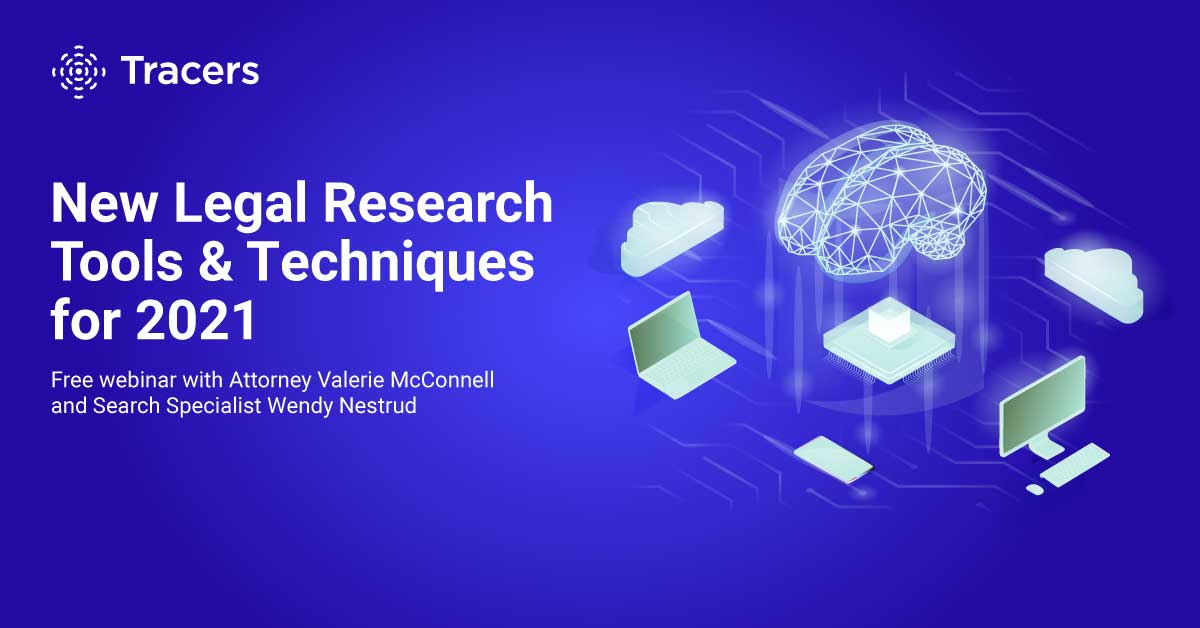Estimated reading time: 4 minutes
This webinar is now available on-demand. Register here and watch now!
With the vast amount of new and easy-to-use technology available for legal research, it’s time for legal professionals to leave traditional and costly legal research solutions in the past. So how do you start taking advantage of new legal research software to help your practice be more cost-effective and efficient? In this webinar, “New Legal Research Tools & Techniques for 2021”, attorney Valerie McConnell and from Casetext and investigative search Specialist Wendy Nestrud discuss tools and techniques that will help you conduct legal research, write briefs, and gather evidence more quickly, focusing in on three specific use cases. Here’s the recap, or watch the entire recording here.
Technologies that can help you establish personal jurisdiction – Overview (05:10)
Why does establishing personal jurisdiction matter? Without it, the court will not be able to make any decisions about the party. And because personal jurisdiction is heavily fact-specific, gaining relevant information quickly is necessary to working in an efficient manner. Learn what kinds of factors impact personal jurisdiction and what you need to demonstrate in order to establish it.
Tools to establish personal jurisdiction (06:33)
While gathering evidence to establish personal jurisdiction has traditionally taken up large amounts of time and resources, new legal research tools have made the research process easier. Specifically, legal professionals can utilize a Comprehensive Person Report, Utility Report, and Social Media Report in order to gather all the necessary information to establish personal jurisdiction more quickly. Listen to Wendy discuss what these tools are, what kinds of relevant information they provide to personal jurisdiction, and how to use these tools in the Tracers software.
Complementary personal jurisdiction Casetext automation tool (17:28)
After using these tools to gather evidence establishing personal jurisdiction, you may face a new problem if the party fights jurisdiction and files a motion to dismiss it. Your next step would be to file an opposition to their motion, but writing this brief can be a tedious process. Enter Compose: a brief automation technology created by Casetext. Valerie teaches you what Compose is and how you can use it to save time and effort when writing motions.
Technologies that can help you with discovery – Overview (24:04)
Discovery can be a large burden for attorneys; tracking down witnesses with traditional methods can be incredibly time-consuming and expensive. Luckily, there are tools available to make the process much easier for busy attorneys. Valerie discusses discovery and why you should use the best skip tracing technology to locate witnesses in your law practice.
Three tools to help with discovery (25:15)
So you’re trying to find somebody? With the right technology, finding witnesses doesn’t have to be hard – or expensive. License Plate Recognition Search and a Telephone Report are three tools you can use to quickly identify witnesses, track them down, and request their depositions. Listen to Wendy explain how these tools can help you with discovery, as well as how to utilize them on your own with Tracers in order to avoid wasting time and hiring costly private investigators.
Complementary discovery Casetext automation tool (35:32)
Although these discovery tools can help you successfully locate and serve witnesses, they don’t help you deal with uncooperative witnesses who fail to comply with subpoenas. In these tricky situations, you’ll want to file a motion to compel discovery. And again, Compose is here to help. Valerie explains how you can use this Casetext brief automation tool to file a motion to compel discovery, without all the hassle of manually searching court arguments and finding supporting standards.
Technologies that can help you with settlement – Overview (41:13)
In order to settle, you need to find information to either pierce the corporate veil or go after other sources of recovery. So how do you find sources of recovery? Valerie discusses settlement and how technology can help you determine which recovery strategy to use for your client.
Two tools to help with settlement (42:26)
Piercing the corporate veil is not an easy task – you have to identify if it’s a viable option and which “deep pockets” to go after. Fortunately, Tracers’ tools can help you get the job done. Two new business searches, UCC filings and Business Credit Report, investigate a party’s relationship to a business and show you the credit worthiness of the business. Wendy demonstrates how you can use these searches in Tracers to gather the facts necessary to pierce the corporate veil and determine how much settlement you can get for your client.
Complementary settlement Casetext automation tool (49:04)
If you’ve gathered information from a Business Credit Report, your next job for settlement is determining if any of it supports your veil piercing theory by finding similar cases. While traditional keyword searches may not show you all relevant cases, you can find them easily with Parallel Search in Casetext – an AI tool trained on the law that recognizes synonyms and concepts. Learn how you can use Parallel Search to find conceptually similar cases so you can determine if the information can be used to pierce the corporate veil and get your client’s settlement.
Register here and watch the entire webinar for free!

